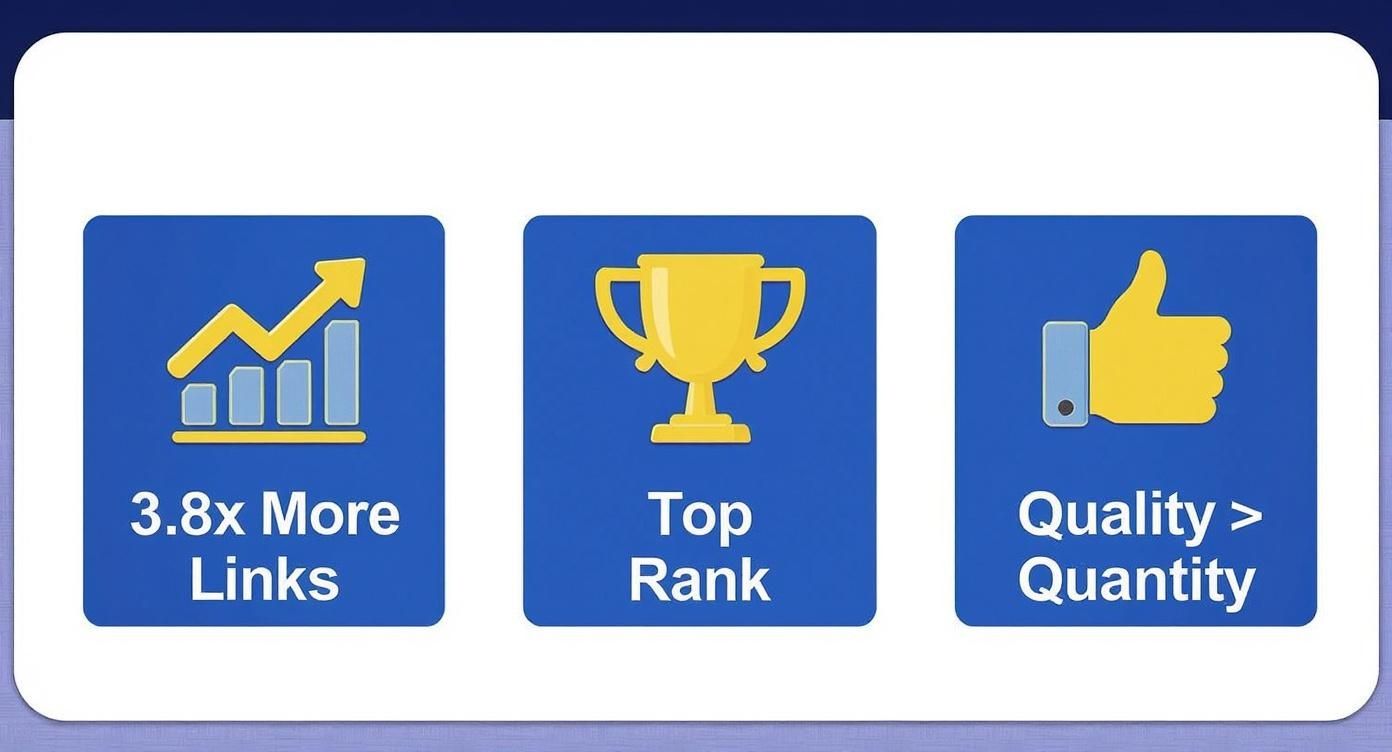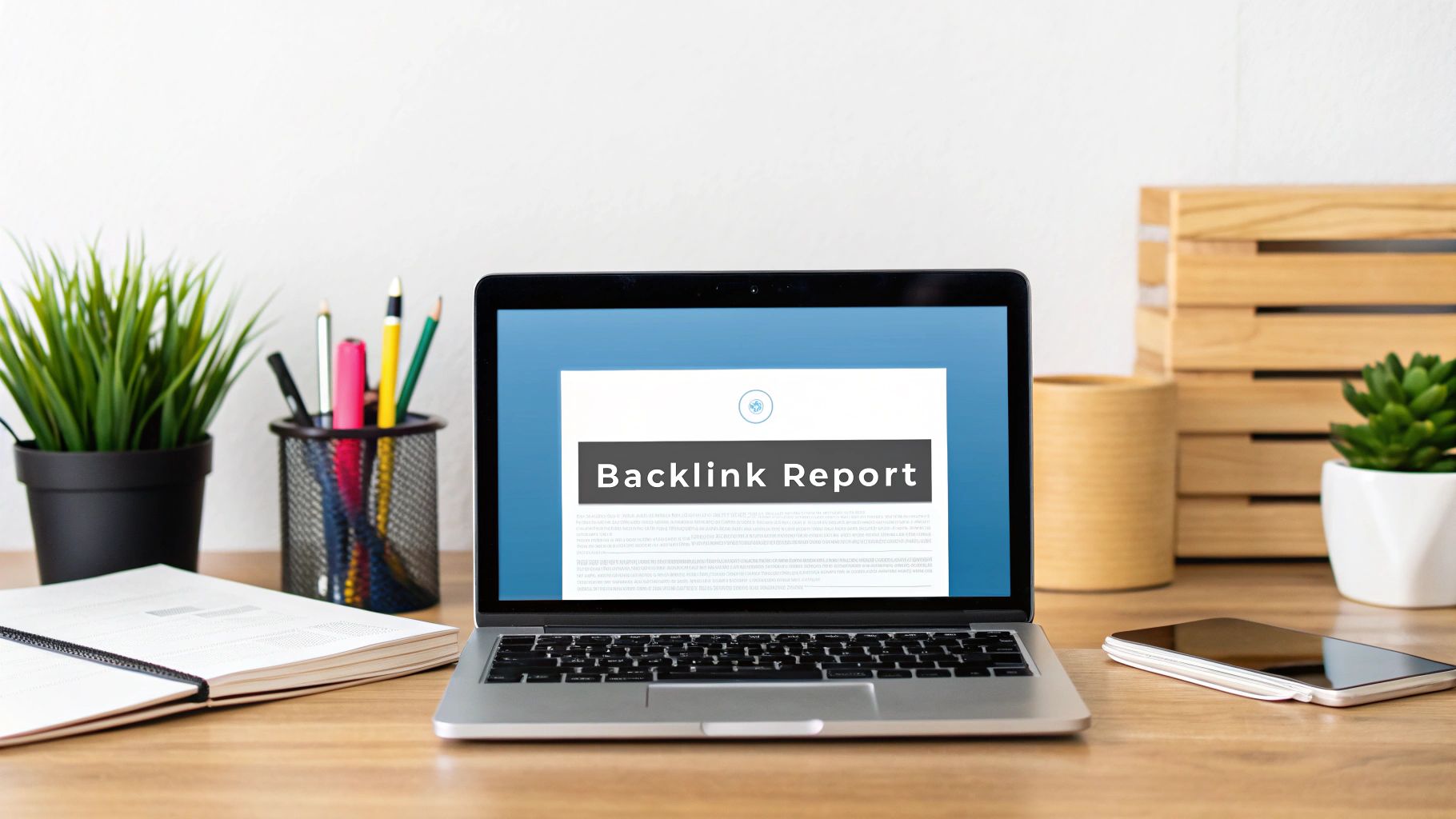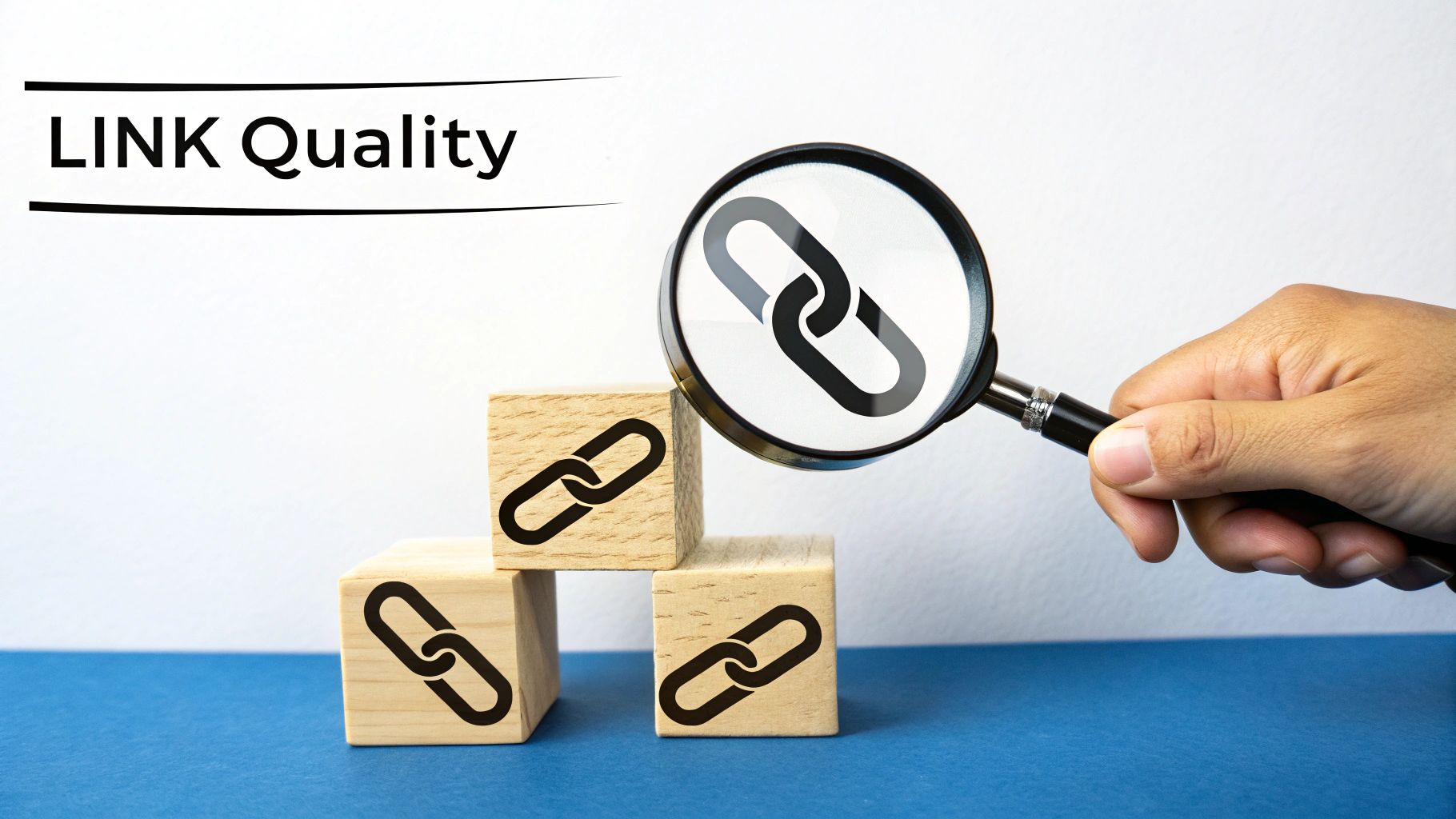
How to Find Backlinks in Google: A Practical Guide
Share
Want to find backlinks without paying for expensive tools? You absolutely can. All you need is Google Search Console to check your own site's links and a few clever advanced Google search operators to spy on your competitors.
Why Backlink Discovery Still Drives SEO Success
Even as Google's algorithm gets smarter, one thing hasn't changed: backlinks are still a massive driver of SEO success. Think of them as a vote of confidence. When another website links to yours, it's telling Google that your page is valuable and trustworthy, which has a direct impact on your rankings.
For a niche business like a restaurant equipment supply website, knowing who links to you is like understanding your reputation in the digital world.
This isn't just about stroking your ego. Digging into your backlink profile gives you some seriously powerful strategic insights.
- Find Your Biggest Fans: You can instantly see which industry blogs, culinary schools, or food publications already like what you're doing.
- Spot Partnership Opportunities: Seeing who links to your competitors but not to you is basically a ready-made outreach list.
- Sharpen Your Content Strategy: When you analyze which pages get the most links, you learn exactly what kind of content resonates with your audience and should create more of.
The Undeniable Impact of a Strong Backlink Profile
The data doesn't lie—there's a rock-solid connection between backlinks and ranking at the top of Google. In fact, the average page in the #1 spot has 3.8 times more backlinks than the pages ranking in positions two through ten.
But it's not just a numbers game. Something like 93.8% of SEO pros agree that the quality of the links matters far more than the quantity. A single link from a highly respected site is worth more than a truckload of links from spammy, low-quality ones.
This infographic really drives home the relationship between links and search performance.

As you can see, more quality links directly translate to better search engine rankings. It's all about a quality-first approach.
Understanding your backlink profile is the first step toward building a stronger online presence. It's not just about counting links; it's about understanding the story they tell about your brand's authority and trust within your niche.
Ultimately, this knowledge gives you a solid foundation to build upon. We provide expert article writing and SEO services to help restaurant equipment suppliers leverage these insights. To put it all together, you'll want to integrate your findings into a broader strategy using these essential Search Engine Optimization techniques that really move the needle on rankings and traffic.
Uncovering Your Backlinks with Google Search Console
While third-party tools are great, your first stop for checking your own backlinks should always be Google Search Console (GSC). It's completely free and gives you a direct line into how Google sees your site, including which websites are vouching for you with a link.
Think of it as the ultimate source of truth for your own domain's backlink profile.
Getting to this data is simple. Once your site is all set up in GSC, just look for the "Links" report in the left-hand menu. This is your command center for everything link-related, covering both the links coming into your site and the ones pointing from one of your pages to another. For our purposes, the "External links" section is where the magic happens.
Decoding the Links Report
The Links report in GSC is your clean, no-frills overview of who is linking to you and what they're linking to.
Here’s a look at the main dashboard you'll see.
This summary gives you the high-level stats: your total number of external links and which pages on your site are getting the most love. Right away, you can see which of your content pieces are pulling their weight and earning authority.
The report is broken down into a few key areas, each telling a different part of your backlink story:
- Top linked pages: This shows you the specific URLs on your site with the most backlinks. If you sell restaurant equipment, you might find that a detailed guide on "Choosing the Best Commercial Charbroilers" is a magnet for links from food bloggers and review sites.
- Top linking sites: Here, you'll see the domains that link to your site most frequently. This is basically your list of top supporters. Finding a well-known culinary institute or a respected industry publication here is a huge win.
- Top linking text: This one is super insightful. It reveals the actual anchor text other sites are using when they link to you, giving you a peek into how they perceive your content. Seeing phrases like "high-quality restaurant equipment" confirms that your brand messaging is hitting the mark.
Think of the "Top linking sites" report as your digital fan club. These are the websites already endorsing your brand. This isn't just data; it's a list of potential partners for future collaborations, guest posts, or outreach campaigns.
You can also dig deeper. Clicking into any of these reports gives you a more granular view. For example, if you click on a specific domain from the "Top linking sites" list, GSC will show you exactly which of your pages they link to. This kind of detail is invaluable for understanding the context and value of each link.
For a more detailed walkthrough on using Google's own tools, check out this a simple guide on checking backlinks in Google. Getting comfortable with GSC is the foundational step you need to take before even thinking about competitor analysis. It's an essential skill for any site owner.
Using Google Search Operators for Competitor Insights
While Google Search Console is fantastic for digging into your own website's data, it’s a closed book when it comes to your competitors. That’s where you have to roll up your sleeves and get a little creative.
By mastering a few advanced search operators, you can turn Google itself into a powerful tool for some digital detective work. It's the best way to figure out how to find backlinks in Google without spending a dime on expensive tools.

This hands-on approach lets you uncover the exact kinds of links your competitors are getting, whether it's guest posts, features on resource pages, or mentions in product reviews. It’s all about spotting the opportunities they’re already winning.
Moving Beyond the Deprecated link: Operator
You might have heard about the link: operator. For years, it was the go-to command for a quick backlink check, but those days are long gone.
That operator is now almost completely deprecated. At best, it gives you a tiny, unreliable sample of a site's links. Honestly, using it today is just a waste of time.
Instead, a much better method is to combine other, more powerful search operators to find pages that mention your competitor. The real magic happens when you string these commands together to slice through the noise and get precisely the results you need. This is how you can find high-quality, relevant opportunities that even paid tools might miss.
The goal isn't just to find any mention of a competitor; it's to find the specific contexts where you could realistically get a link, too.
Practical Search Commands for Link Prospecting
Let's run through a real-world scenario. Imagine you run a website selling commercial charbroilers, and your main competitor is "GrillMastersSupply.com." You can use some clever search strings to find out exactly who is talking about them and why.
Here are a few combinations you can plug right into Google:
-
Find Guest Posts: Use a query like
"guest post by" OR "contributed by" intext:"GrillMastersSupply.com" -site:GrillMastersSupply.com. This is perfect for finding articles your competitor has written on other websites. -
Uncover Resource Pages: A search like
inurl:resources OR inurl:links "restaurant equipment" intext:"GrillMastersSupply.com" -site:GrillMastersSupply.comcan reveal pages that list helpful industry resources—including your competitor. -
Locate Brand Mentions in Reviews: Try something like
"best commercial charbroilers" OR "charbroiler reviews" intext:"GrillMastersSupply.com" -site:GrillMastersSupply.com. This helps you find review sites and blogs discussing products in your niche and giving the competition a shout-out.
This method is all about thinking like a link builder. You're not just looking for links; you're looking for the types of content and the websites that are open to linking to businesses just like yours. Every search result is a potential lead for your own outreach campaign.
To help you get started, here’s a quick-reference table with some of my go-to combinations.
Effective Google Search Operator Combinations
| Operator Combination | Purpose | Example for a Restaurant Supply Website |
|---|---|---|
"guest post" intext:"competitor.com" |
Finds guest posts by a competitor, showing you which sites accept them. | "guest post by" intext:"GrillMastersSupply.com" |
inurl:resources "keyword" "competitor.com" |
Identifies resource pages that link to your competitor. | inurl:resources "kitchen supplies" "GrillMastersSupply.com" |
"keyword reviews" intext:"competitor.com" |
Uncovers review articles and roundups that mention your competitor. | "commercial oven reviews" intext:"GrillMastersSupply.com" |
"competitor.com" -site:competitor.com |
Locates general brand mentions across the web (unlinked mentions). | "GrillMastersSupply.com" -site:GrillMastersSupply.com |
Mixing and matching these operators can uncover a surprising number of opportunities that are ripe for the taking.
It's important to remember that finding backlinks through Google alone isn't a perfect science, mainly because Google no longer offers a direct public backlink tool. This is why most SEO professionals rely on third-party tools that crawl the web constantly. Think of this Google Search method as a powerful, free alternative. For a deeper dive, you can discover more insights about modern link-building statistics that show how the industry has adapted.
By systematically working through these searches, you can build a solid list of high-potential websites to target for your own link-building campaigns.
How to Separate High-Quality Links from Digital Noise
Finding a backlink with a Google search operator or GSC is really just the first step. The real work starts when you have to figure out if that link is actually any good, because not all backlinks are created equal. Seriously, a single, powerful link from a well-respected site can do more for your rankings than a hundred junk links.
This is where you need to put on your analyst hat and think critically. If you run a restaurant equipment supply website, a link from a famous culinary blog is pure gold. But a random link from an unrelated tech blog? It’s pretty much worthless.
The goal is to learn how to spot genuine endorsements that build your authority versus digital noise that just clutters up your link profile.
The Core Pillars of a Quality Backlink
When you’re looking at a backlink, you’re essentially looking for signals of trust and relevance. That's exactly what Google's algorithm does, too, so your assessment needs to line up with what it's looking for.
I always focus on these three things:
- Topical Relevance: Does the website linking to you operate in your niche? A link from a food service publication directly reinforces your site's authority on restaurant equipment. It’s a clear signal to Google that you’re a key player.
- Domain Authority: Is the linking site a big, established name in the industry? A link from a major brand carries way more weight than one from some brand-new blog that just popped up last week.
- Link Context: Where is the link located on the page? An in-content link, surrounded by text that’s actually relevant to the topic, is far more valuable than a link buried in a footer or a massive directory list.
Getting this right is so important because a link’s value is tied directly to the authority of the site it comes from. Studies consistently show that backlinks from high-authority domains vastly outperform tons of backlinks from low-authority or spammy sites. The trustworthiness and relevance of the linking site are everything.
On top of that, "link rot" is a real problem. Research shows that over 66% of backlinks naturally break or disappear over time, which makes ongoing monitoring a must. You can dig deeper into some fascinating SEO statistics and trends on ExplodingTopics.com.
Spotting Red Flags and Toxic Links
Just as important as finding good links is knowing how to spot the bad ones. Toxic backlinks can actually hurt your site's rankings, and pretending they don't exist is a risky game.
A healthy backlink profile is like a curated network of professional references. You want endorsements from respected experts in your field, not from questionable sources that could tarnish your reputation.
Keep an eye out for these common red flags:
- Links from spammy directories: These are low-quality sites built for the sole purpose of linking out. They offer zero value.
- Irrelevant foreign language sites: Unless you’re an international business, these are almost always a sign of spam.
- Over-optimized anchor text: If every link uses the exact same keyword in a way that feels forced and unnatural, that's a huge red flag. It’s also smart to understand things like reciprocal link exchanges for SEO, which can sometimes be a gray area.
- Site-wide links: Links that show up on every single page of a site (like in the footer) are often devalued by Google because they’re not editorial endorsements.
If you start seeing a pattern of these types of links pointing to your website, it might be time to look into Google's disavow tool. I always say this should be a last resort, but it’s a necessary tool for protecting your site from toxic backlinks you just can't get removed.
Turning Your Backlink Findings into an Action Plan
Information without action is just data. After you've spent time learning how to find backlinks in Google, the real work begins: turning all that research into a tangible link-building strategy that actually gets results.

This is where your competitor analysis and GSC reports become a roadmap for earning high-quality, relevant links that will boost your site's authority. Your goal is to move from simply knowing who links to your competitors to creating a prioritized hit list of your own outreach targets.
Building Your Targeted Outreach List
First things first, you need to get organized. I always recommend starting with a simple spreadsheet to track the opportunities you've dug up from your Google search operator investigations.
If you're a restaurant equipment supplier, for example, your list might include culinary blogs, food service industry publications, and equipment review sites you found linking to your competitors.
Your spreadsheet doesn't have to be complicated. Just make sure you're tracking a few key details for each potential link:
- Target Domain: The website you want a link from.
- Link Type: Is it a guest post, a spot on a resource page, or a product review?
- Contact Information: A name or email for your outreach. You might have to do some digging for this.
- Reason for Outreach: Jot down why they are a good fit. (e.g., "They linked to our competitor's charbroiler guide, and ours is more up-to-date.").
- Status: A simple tracker is all you need (e.g., Not Started, Contacted, Link Secured).
This organized approach transforms a messy list of domains into a manageable campaign. Now you can prioritize based on the sites with the highest relevance and authority, focusing your efforts where they'll have the most impact. For a much deeper dive into this process, our guide on effective guest posting outreach lays out a detailed framework.
Pursuing Link Reclamation Opportunities
One of the quickest wins in link building is link reclamation. This is all about finding mentions of your brand, products, or content that don't actually include a link back to your site.
Running a search operator like "Your Brand Name" -site:yourdomain.com is a great way to uncover these unlinked mentions. When you find one, reaching out to the site owner with a polite request to add a link is often an easy win.
Think of link reclamation as collecting money that's already yours. The site already chose to mention you; they just need a small nudge to make that mention an official, authority-building backlink.
Another powerful reclamation tactic is hunting for broken links pointing to your competitors. Let's say you find a resource page linking to a 404 error on a competitor's site. You can swoop in, contact the editor, point out their broken link, and suggest they replace it with a link to your similar (and hopefully better) resource.
This helps them fix their site while earning you a valuable link. It’s a classic win-win scenario that builds goodwill and your backlink profile at the same time.
Frequently Asked Questions

When you first start digging into backlinks, a lot of questions pop up. It's totally normal. Let's clear up some of the most common things people ask when they're learning how to find backlinks in Google.
Can I See All My Competitor's Backlinks Using Only Google?
Short answer: no. You can't get a complete picture of a competitor's link profile with just Google's tools.
The old link: search operator is pretty much useless now. It might show you a handful of links, but it’s a tiny, random sample at best. Don't rely on it.
And while Google Search Console is fantastic, it's designed to show you your own backlinks for sites you've verified. You simply can't peek at your competition's GSC data.
For a deep dive into your competitors' link profiles, you'll need to use a dedicated third-party SEO tool. But for a quick, free look using Google's own ecosystem, the search operator tricks we covered are as good as it gets.
How Often Should I Check My Backlinks In Google Search Console?
As a general rule, checking your backlink profile in Google Search Console at least once a month is a solid habit. This gives you a regular chance to see new referring domains pop up and catch any spammy or weird links before they cause issues.
However, if you're in the middle of a serious link-building push or just launched a big content piece—say, a massive guide to commercial charbroilers—you'll want to check more often. In those situations, a weekly check-in can give you real-time feedback on how your efforts are paying off.
What Is The Difference Between A Nofollow And A Dofollow Link?
Getting the hang of this distinction is critical because these two link types send completely different messages to search engines.
- Dofollow Link: This is your standard, bread-and-butter backlink. It's the most valuable kind for SEO because it passes authority—what we often call "link juice"—from the linking website to yours. Think of it as a genuine vote of confidence.
-
Nofollow Link: This link has a special
rel="nofollow"tag attached. It basically tells search engines not to pass any authority through it. While they won't give you a direct ranking boost, they're not worthless. They can still send great referral traffic and help your link profile look natural to Google.
Even though Google now says it treats "nofollow" more like a suggestion than a hard rule, dofollow links are still the gold standard and the main target for any link-building campaign.
At RestaurantEquipmentSEO.com, we understand that a powerful backlink profile is just as crucial as having top-notch kitchen equipment. We specialize in providing comprehensive SEO, local citation services, blog posting, and blogger outreach for restaurant equipment supply websites. Let us help you build the online authority you need to conquer your market. Contact us today to learn more about our tailored content and SEO strategies.
